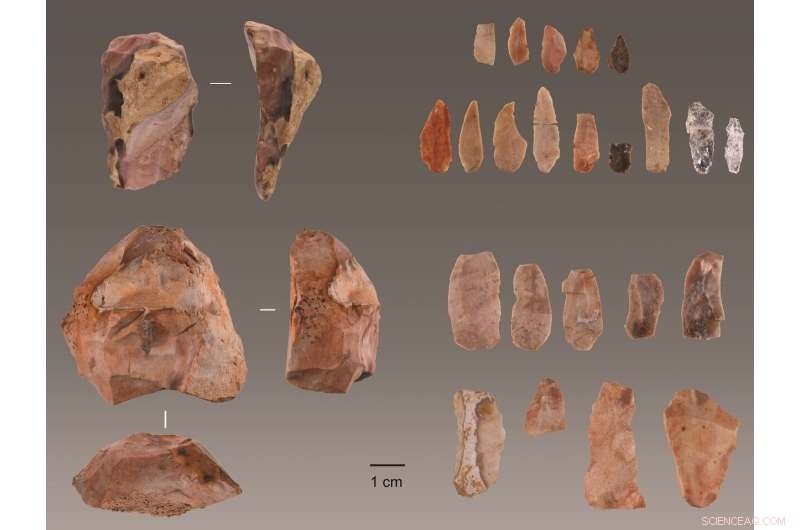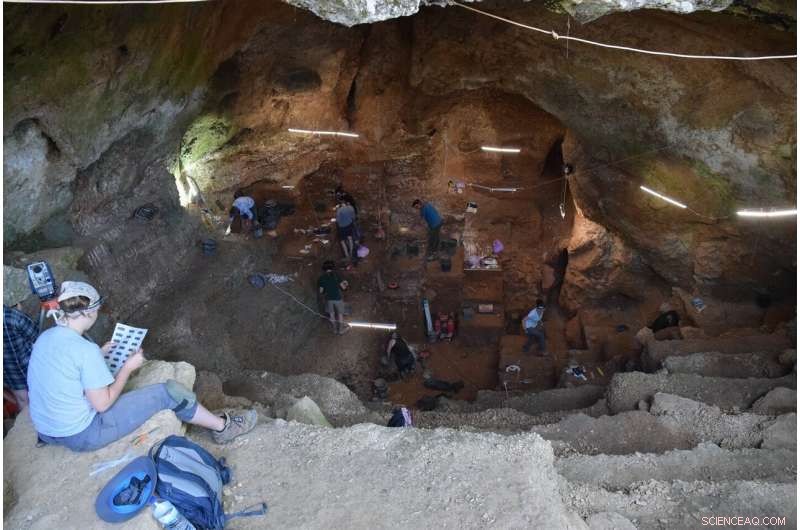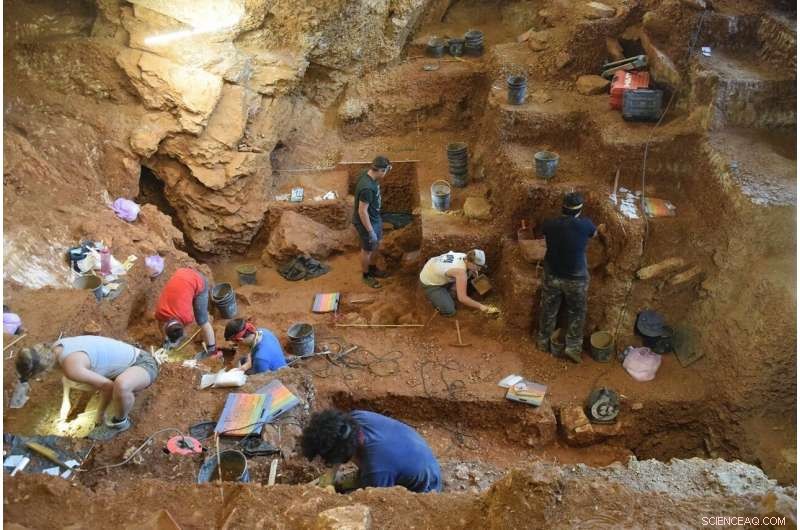
Strumenti scoperti a Lapa do Picareiro nel Portogallo centrale. Credito:Jonathan Haws.
L'uomo moderno è arrivato nella parte più occidentale dell'Europa 41, 000—38, 000 anni fa, circa 5, 000 anni prima di quanto precedentemente noto, secondo Jonathan Haws, dottorato di ricerca, professore e presidente del Dipartimento di Antropologia dell'Università di Louisville, e un team internazionale di ricercatori. Il team ha rivelato la scoperta di strumenti di pietra usati dagli esseri umani moderni risalenti al periodo precedente in un rapporto pubblicato questa settimana sulla rivista Atti dell'Accademia Nazionale delle Scienze .
Gli attrezzi, scoperto in una grotta chiamata Lapa do Picareiro, situato vicino alla costa atlantica del Portogallo centrale, collegare il sito con reperti simili da tutta l'Eurasia alla pianura russa. La scoperta supporta una rapida dispersione verso ovest degli umani moderni in tutta l'Eurasia entro poche migliaia di anni dalla loro prima apparizione nell'Europa sudorientale. Gli strumenti documentano la presenza di esseri umani moderni nell'Europa più occidentale in un'epoca in cui si pensava che i Neanderthal fossero presenti nella regione. Il ritrovamento ha importanti ramificazioni per comprendere la possibile interazione tra i due gruppi umani e la definitiva scomparsa dei Neanderthal.
"La domanda se gli ultimi Neanderthal sopravvissuti in Europa siano stati sostituiti o assimilati dagli umani moderni in arrivo è una questione di vecchia data, problema irrisolto in paleoantropologia, "ha detto Lukas Friedl, un antropologo dell'Università della Boemia occidentale a Pilsen, Repubblica Ceca, e co-responsabile del progetto. "Le prime date per gli strumenti di pietra aurignaziani a Picareiro probabilmente escludono la possibilità che gli umani moderni siano arrivati nella terra a lungo priva di Neanderthal, e questo di per sé è eccitante."
Fino ad ora, le più antiche testimonianze di uomini moderni a sud del fiume Ebro in Spagna provenivano da Bajondillo, un sito di grotte sulla costa meridionale. La scoperta di sgabelli in pietra caratterizzati come aurignaziani, tecnologia associata ai primi esseri umani moderni in Europa, in un contesto stratigrafico sicuro a Picareiro forniscono prove definitive dell'arrivo umano della prima età moderna.
"Bajondillo ha offerto prove allettanti ma controverse che gli umani moderni erano nella zona prima di quanto pensassimo, " Haws ha detto. "Le prove nel nostro rapporto supportano sicuramente le implicazioni di Bajondillo per un primo arrivo umano moderno, ma non è ancora chiaro come siano arrivati qui. Le persone probabilmente migrarono lungo i fiumi che scorrono da est a ovest nell'interno, ma un percorso costiero è ancora possibile".
"La diffusione di esseri umani anatomicamente moderni in tutta Europa molte migliaia di anni fa è fondamentale per la nostra comprensione di dove veniamo come specie ora globale, " ha detto John Yellen, direttore del programma di archeologia e archeometria presso la National Science Foundation, che ha sostenuto l'opera. "Questa scoperta offre nuove prove significative che aiuteranno a modellare la ricerca futura che indagherà su quando e dove gli umani anatomicamente moderni sono arrivati in Europa e quali interazioni potrebbero aver avuto con i Neanderthal".

Vista di Lapa do Picareiro guardando dall'ingresso. Credito:Jonathan Haws
La grotta di Picareiro è stata scavata per 25 anni e ha prodotto un record di occupazione umana negli ultimi 50, 000 anni. Un team di ricerca internazionale del Centro interdisciplinare per l'archeologia e l'evoluzione del comportamento umano (ICArEHB) di Faro, Portogallo, sta studiando l'arrivo degli esseri umani moderni e l'estinzione dei Neanderthal nella regione.
Il progetto è guidato da Haws, Michael Benedetti dell'Università della Carolina del Nord Wilmington, e Friedl, in collaborazione con Nuno Bicho e João Cascalheira dell'Università dell'Algarve, dove è ospitato ICArEHB, e Telmo Pereira dell'Università Autonoma di Lisbona.
Con il sostegno delle sovvenzioni della National Science Foundation degli Stati Uniti a Haws e Benedetti, il team ha scoperto ricchi giacimenti archeologici che includono strumenti di pietra in associazione con migliaia di ossa di animali provenienti dalla caccia, attività di macelleria e cucina.
Sahra Talamo dell'Università di Bologna, Italia, e il Max Planck Institute for Evolutionary Anthropology di Lipsia, Germania, joined the research team to determine the age of the early modern human and Neanderthal occupations. She used state-of-the-art bone pretreatment and accelerator mass spectrometry (AMS) to date the bones that show evidence of butchery cut marks and intentional breakage by humans to extract bone marrow, a highly prized and nutritious food consumed by ancient people. The dating results place the modern human arrival to the interval between 41, 000 and 38, 000 anni fa. The last Neanderthal occupation at the site took place between 45, 000 and 42, 000 anni fa.
"The radiocarbon results from Lapa do Picareiro are not only very precise in terms of the dating method, but also demonstrate the meticulous work of the archeologists at the site, " Talamo said. "The importance of collaboration between the radiocarbon specialist and the archaeologists is essential in order to obtain an accurate chronology like in the case of Picareiro."
Spatial analysis of high-resolution three-dimensional data confirmed the precise stratigraphic relationships between artifacts and radiocarbon samples and revealed discrete layers of occupation at the site.
"Analysis of high-resolution spatial data is crucial for documenting and observing lenses of human occupation and reconstructing occupational patterns, especially in cave environments where complex formation processes exist, " said Grace Ellis, un dottorato di ricerca student at Colorado State University studying landscape archaeology and ancient settlement patterns.

View of the excavation of the early modern human (foreground) and Neanderthal layers (background) of Lapa do Picareiro. Credit:Jonathan Haws
This was backed up by artifact refitting that showed the stone tools were not moved through post-depositional processes.
"Refitting is a task that requires a lot of time and patience, e in questo caso, it really was worthwhile because the results verified the geospatial observations, " said Pereira, an archaeologist who specializes in stone technology.
While the dates suggest that modern humans arrived after Neanderthals disappeared, a nearby cave, Oliveira, has evidence for Neanderthals' survival until 37, 000 anni fa. The two groups may have overlapped for several thousand years in the area.
"If the two groups overlapped for some time in the highlands of Atlantic Portugal, they may have maintained contacts between each other and exchanged not only technology and tools, but also mates. This could possibly explain why many Europeans have Neanderthal genes, " said Bicho, director of ICArEHB.
"Besides genetic and archeological evidence, high-resolution temporal context and fossil evidence across the continent is crucial for answering this question. With the preserved key layers dated to the transitional period, we are now awaiting human fossils to tell us more about the nature of the transition, " Friedl said.
Despite the overlap in dates, there does not appear to be any evidence for direct contact between Neanderthals and modern humans. Neanderthals continued to use the same stone tools they had before modern humans arrived, bringing a completely different stone technology.
"Differences between the stone tool assemblages dated before and after about 41, 000 years ago are striking at Picareiro, " said Cascalheira, an ICArEHB board member and specialist on stone tool technology. "Older levels are dominated by quartzite and quartz raw materials and marked by the presence of Levallois technology, a typical element of Neanderthal occupations in Europe. Aurignacian levels, d'altra parte, are dominated by flint and the production of very small blades that were likely used as inserts in arrow shafts for hunting."
Flint also was used to make tools for butchering animals such as red deer, ibex and possibly rabbits. The team recovered a few red deer canine teeth, often used as personal adornments, but so far these do not show traces of manufacturing jewelry.
"The bones from Lapa do Picareiro make up one of the largest Paleolithic assemblages in Portugal, and the preservation of these animal bones is remarkable, " said Milena Carvalho, un dottorato di ricerca candidate at the University of New Mexico and ICArEHB researcher studying the diets and paleoecology of Neanderthals and modern humans. "The collection will provide tremendous amounts of information on human behavior and paleoecology during the Paleolithic and we will be studying it for decades."
The cave sediments also contain a well-preserved paleoclimatic record that helps reconstruct environmental conditions at the time of the last Neanderthals and arrival of modern humans.
"We studied changes in the size of limestone clasts and the chemistry of muddy fine sediment filling the cave to understand the paleoclimatic context for the transition, " Benedetti said. "Our analysis shows that the arrival of modern humans corresponds with, or slightly predates, a bitterly cold and extremely dry phase. Harsh environmental conditions during this period posed challenges that both modern human and Neanderthal populations had to contend with."
The cave itself has an enormous amount of sediment remaining for future work and the excavation still hasn't reached the bottom.
"I've been excavating at Picareiro for 25 years and just when you start to think it might be done giving up its secrets, a new surprise gets unearthed, " Haws said. "Every few years something remarkable turns up and we keep digging."